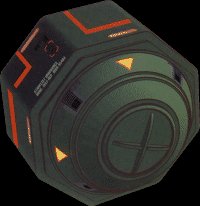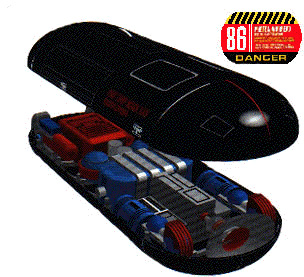| Description :Advances in rapid energy extraction from the space-time domain known as the zero-point vacuum eventually led the Starfleet R&D facility on Groombridge 273-2A to test a prototype continuum-twist device with a calculated potential of 52.3 isotons. Zero-point energy generation began with a negative energy balance, requiring a greater input of high-temperature EPS plasma to initate the |
 |
reaction than what was actually produced by the zero point field device. The basic mechanism, first operated experimently in 2236, involved the formation of an 11- dimensional space-time membrane. A cousin of the superstring, the membrane was twisted into a string with a topology of Genus 1 and pinched off from the background vacuum, calling into existence a new particle. The process of creating large numbers of new subatomic particles liberated correspondingly large amounts of energy. Calculations quickly showed that a relatively small volume of ultraclean vacuum carried aboard a torpedo warhead could place a highly explosive energy release on a target. The testing of the prototype zero-point warhead occurred on Groombridge 273-2A, an uninhabited gas-giant moon, in 2355, following six years of theoretical research and experiemental hardware development. Various types of EM emitters were successful at producing energy bursts, and one was chosen for a detonation test 285 kilometers beneath the surface. The test was successful.
The assembly is penetrated by a single opening in the tapered end, cut by a nanometer phaser in an inert atmosphere of argon and neon. Two jacketing layers, one of synthetic neutronium and another of dilithium, control the upper and lower extremes of the energy-field contours. Attached to the taper opening is a zero-point initiator consisting of an EM rectifier, waveguide bundle, subspace field amplifier, and continuum distortion emitter. The emitter creates the actual pinch field from a conical spike 10E-16 meters across at the tip. The zero-point initiator is powered by the detonation of an uprated photon torpedo warhead with a yield of 21.8 isotons, achieved through increased matter-antimatter surface area contact and introduction of fluoronetic vapor. The M/A reaction occurs at four times the rate of a standard warhead. The detonation energy is channeled through the initiator within 10E-7 seconds and energizes the emitter, which imparts a tension force upon the vacuum domain. As the vacuum membrane expands, over a period of 10E-4 seconds, an energy potential equivalent to at least 50 isotons is created. This energy is held by the chamber for 10E-8 seconds and is then released by the controlled failure of the chamber wall. |
PULSE PHASER CANNON
|
|
|
| Number |
4
|
| Location |
2 above and 2 below the nacelle root attachments to the main body
|
| Description |
The development of the pulse phaser cannon applies a number of lessons learned at the Starfleet Tokyo R&D facility, where large, nearly flawless emitter crystals had been grown in ground-based microgravity chambers. The new crystals, combined with rapid-discharge EPS capacitance banks and high-speed beam-focusing coils, allowed the phaser discharge to be stored temporarily (up to 2.3 nanoseconds) within the coils and then released as a layered pulse. The emerging pulse is structured something like an onion and is able to land a target contact that is more difficult to disperse than a standard phaser beam.
|
SELF REPLICATING MINES
|
|
|
| Description :An Ingeniousdevice, the concept of the self replicating mine was first suggested by Technician Rom aboard Deep Space 9 in response to the threat of Dominion reinforcements entering the Alpha Quadrant via the Bajoran Wormhole. They work by employing a network of replicator units that draw replicator mass from each other to replace lost mines as necessary. The mine warhead itself is developed from a modified Photon Torpedo warhead that is set to detonate the moment any moving object reaches within 500 metres of the mine, producing an explosive yield equal to that of a Photon Torpedo. |

|
CLOAKING DEVICE
|
|
|
Type : Klingon (specific model unknown
Range : The cloaking field envelops the hull of the ship itself to minimize subspace distortion. During warp flight, the cloak is extended to mask the warp field.
Output : When active, all defensive system power is transferred to the cloak, which gives it enough power to fully cloak the strong signature that Defiant class puts out. The total amount of power used is classified, but goes into the gigawatt range. The cloak masks all energy put out by Defiant class , making it virtually invisible to everything except the most powerful subspace scanner. Conjecture
|
ABLATIVE ARMOUR
|
|
|
The ablative armor hull plating on the Defiant class is capable of protecting the ship from heavy attack with the shields down (amount of time is unknown). The armor works in two stages; in the event of shield-envelope disruption, phaser or thermal EM is first dissipated over the hull surface, and above an undisclosed threshold causes the molecular matrix to boil off at a controlled rate, carrying away a large fraction of the landed beam energy. In most cases, the boil-off creates a medium density particle cloud, which may help disperse the incoming beam.
|


